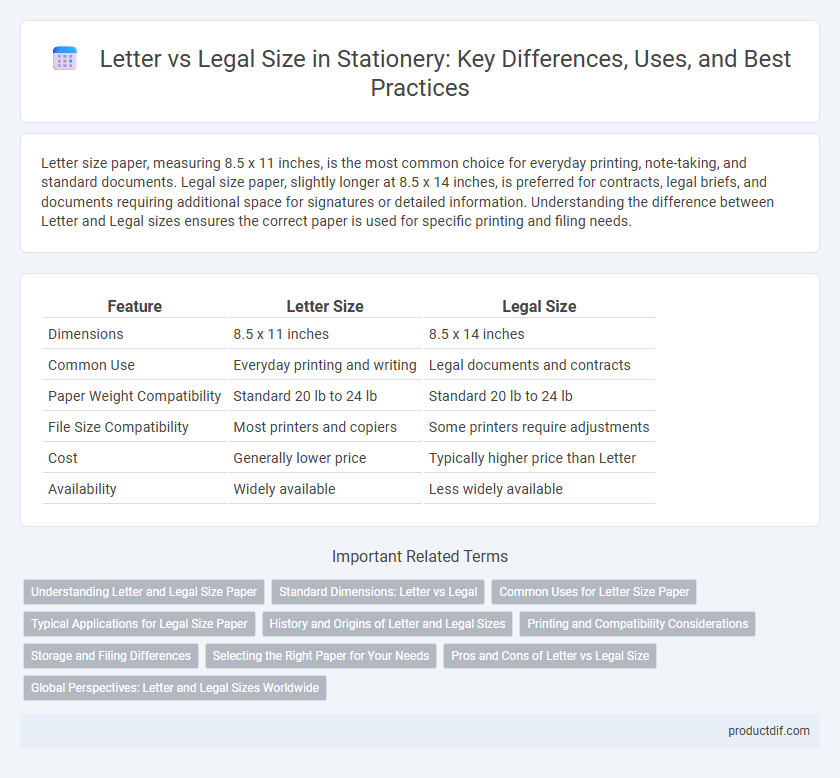Letter size paper, measuring 8.5 x 11 inches, is the most common choice for everyday printing, note-taking, and standard documents. Legal size paper, slightly longer at 8.5 x 14 inches, is preferred for contracts, legal briefs, and documents requiring additional space for signatures or detailed information. Understanding the difference between Letter and Legal sizes ensures the correct paper is used for specific printing and filing needs.
Table of Comparison
| Feature | Letter Size | Legal Size |
|---|---|---|
| Dimensions | 8.5 x 11 inches | 8.5 x 14 inches |
| Common Use | Everyday printing and writing | Legal documents and contracts |
| Paper Weight Compatibility | Standard 20 lb to 24 lb | Standard 20 lb to 24 lb |
| File Size Compatibility | Most printers and copiers | Some printers require adjustments |
| Cost | Generally lower price | Typically higher price than Letter |
| Availability | Widely available | Less widely available |
Understanding Letter and Legal Size Paper
Letter size paper measures 8.5 x 11 inches and is commonly used for everyday printing and standard documents in the United States. Legal size paper, larger at 8.5 x 14 inches, is typically utilized for contracts, legal documents, and forms requiring extra length. Selecting the appropriate paper size ensures proper formatting and compliance with industry standards in office and legal environments.
Standard Dimensions: Letter vs Legal
Letter size paper measures 8.5 x 11 inches, commonly used for everyday printing and correspondence, while Legal size paper is 8.5 x 14 inches, preferred for official documents requiring extra length. The extended 3-inch length of Legal size provides additional space for contracts, agreements, and legal paperwork. Choosing the appropriate standard dimension ensures compatibility with printers, filing systems, and document formatting standards in offices.
Common Uses for Letter Size Paper
Letter size paper, measuring 8.5 x 11 inches, is commonly used for everyday printing tasks such as letters, reports, and school assignments. It is the standard size for most office printers and copiers, making it ideal for business correspondence and document preparation. This size also suits personal use, including resume printing and note-taking.
Typical Applications for Legal Size Paper
Legal size paper, measuring 8.5 x 14 inches, is commonly used for contracts, legal documents, and government forms that require extra space for detailed content and signatures. It is favored in law offices, real estate transactions, and financial institutions where extended margins accommodate official stamps and annotations. The larger format helps organize complex information clearly, making it essential for professional documentation and record-keeping.
History and Origins of Letter and Legal Sizes
Letter size paper, measuring 8.5 x 11 inches, originated in the United States during the early 20th century as a standardized format for office and personal use, evolving from earlier business letter formats. Legal size paper, defined as 8.5 x 14 inches, was developed primarily for legal documents to provide extra space for detailed contracts and notations, reflecting its specialized use in the legal profession. Both sizes became widely adopted due to the American National Standards Institute (ANSI) efforts to standardize office paper dimensions.
Printing and Compatibility Considerations
Letter size paper measures 8.5 x 11 inches, while legal size is longer at 8.5 x 14 inches, impacting printing layouts and document formatting. Printers usually support letter size by default, but some may require manual adjustments or specific trays to handle legal size, influencing compatibility and ease of use. Choosing between letter and legal size depends on the intended document type, printer capabilities, and the need for additional content space.
Storage and Filing Differences
Letter size paper measures 8.5 x 11 inches, fitting standard filing cabinets and folders designed for everyday office documents. Legal size is larger at 8.5 x 14 inches, requiring extended storage solutions and deeper drawers to accommodate its length without folding. Choosing between letter and legal size impacts space efficiency and organization in physical filing systems.
Selecting the Right Paper for Your Needs
Letter size paper measures 8.5 x 11 inches, ideal for everyday printing, letters, and documents, while legal size paper is 8.5 x 14 inches, suited for contracts, legal documents, and forms requiring extra length. Choosing between letter and legal size depends on the document type, printer compatibility, and filing system requirements. Ensuring the correct paper size streamlines workflow, maintains professionalism, and meets industry standards.
Pros and Cons of Letter vs Legal Size
Letter size paper (8.5 x 11 inches) offers better compatibility with most printers and easier handling for everyday documents, making it ideal for personal and office use. Legal size paper (8.5 x 14 inches) provides extra length, which is beneficial for contracts and legal documents that require more detailed information without page breaks. However, legal size can be cumbersome for filing and standard printer use, potentially leading to higher printing costs and storage challenges compared to letter size.
Global Perspectives: Letter and Legal Sizes Worldwide
Letter size paper, measuring 8.5 x 11 inches, is predominantly used in the United States, Canada, and Mexico, making it the standard for everyday documents and office printing in North America. Legal size paper, which is 8.5 x 14 inches, is often preferred for formal contracts and legal documents primarily in the U.S. Meanwhile, most countries worldwide adopt the A4 size (210 x 297 mm) based on the ISO 216 standard, which differs significantly from both Letter and Legal sizes, influencing international document formatting and stationery compatibility.
Letter vs Legal Size Infographic

 productdif.com
productdif.com